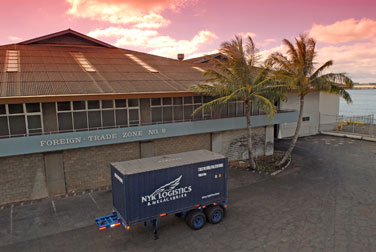|
|
|
|||||||||||||||||||||||
|
U.S. Foreign-Trade Zones Offer Flexibility in a Changing Environment Recent innovations implemented by the U.S. Foreign-Trade Zones program are helping to ensure that this dynamic program responds to the needs of U.S. exporters in today’s marketplace. by Pierre Duy and Elizabeth Whiteman Companies large and small—in industries ranging from oil refining and shipbuilding to chemicals and electronics—turn to the U.S. Foreign-Trade Zones (FTZ) program to maximize the international competitiveness of their U.S. operations.
Operating in an FTZ provides several customs benefits for U.S. facilities. Imported merchandise can be brought into an FTZ, stored or manufactured, and reexported without payment of duty. Duty is deferred on any merchandise that is ultimately for sale in the United States. Also, with FTZ Board approval, duty can be reduced if the duty rate on a finished product manufactured in an FTZ is less than the duty rate on the imported components. This type of savings may be important to retaining domestic production when key manufacturing components are produced only overseas. FTZ operators may also qualify for other customs benefits, such as weekly entry or direct delivery procedures. 74 Years of Facilitating Trade The Foreign-Trade Zones Act of 1934 created the FTZ program. The FTZ Board has the power to designate specific locations within the United States where foreign goods can be stored in duty-free status under the supervisions of U.S. Customs and Border Protection. (Story continues below.)
Over the years, the FTZ program has evolved to encompass manufacturing and other operations at multiple-user ports and industrial parks (or general-purpose zone sites), as well as at the individual facilities of participating companies (or subzones). Changes in the program maintain the program’s goal of expediting trade and encouraging activity in the United States that might otherwise be done abroad. New Procedures Simplify Participation In 2004, as part of the Commerce Department’s Manufacturing Initiative, the FTZ Board reexamined its procedures and recognized that small and medium-sized enterprises (SMEs) were facing hurdles to using the program. As a result, a number of improvements were made to upgrade and simplify access to FTZ procedures. For example, old-style application guidelines were replaced with a more straightforward question-and-answer format, the FTZ Board’s Web site was redesigned to provide more information, and outreach and application counseling were significantly extended and enhanced. The biggest change was a new application process designed to provide manufacturers, especially SMEs, with faster access to FTZ procedures so they could respond to quickly changing industry conditions. The new process—temporary/interim manufacturing (T/IM) authority—allows any company in an FTZ to request manufacturing authority similar to recent FTZ Board approvals and to benefit from a rapid, 75-day processing time. To facilitate applications, a searchable database of recent approvals is available on the FTZ Board’s Web site. Quick approval of T/IM authority enables a manufacturer to respond to a new opportunity or to begin production under FTZ procedures while awaiting permanent authority from the FTZ Board. Permanent authority can be requested at the same time as T/IM authority, and a single application form eliminates any extra burden. Supporting U.S. Manufacturing The advantages offered by FTZ procedures and the new T/IM authority can provide real benefits to U.S.–based manufacturers that are competing with foreign manufacturers. For example, Perkins Shibaura Engines LLC, a joint venture between Perkins Engines (a Caterpillar company) and IHI Shibaura Machinery Co. Ltd., established a new diesel engine manufacturing facility that has 130 employees within an FTZ in Griffin, Georgia. The Perkins Shibaura plant produces three- and four-cylinder engines for the U.S. market and for export to Latin America and Canada. To reduce production costs at the facility and to make U.S. production feasible, the company sought the use of FTZ procedures—specifically T/IM authority—to reduce its customs duty costs by up to $500,000 per year. T/IM authority was subsequently granted and will help equalize the facility’s customs costs with Perkins Shibaura’s overseas plants. Company officials say that the savings may ultimately help expand the U.S. plant’s capacity to 60,000 engines per year. After almost 75 years, FTZs continue to “expedite and encourage foreign commerce,” thereby fulfilling the legislative mandate that established them in 1934. Pierre Duy and Elizabeth Whiteman are staff analysts for the Foreign-Trade Zone Board.
|
|
||||||||||||||||||||||
